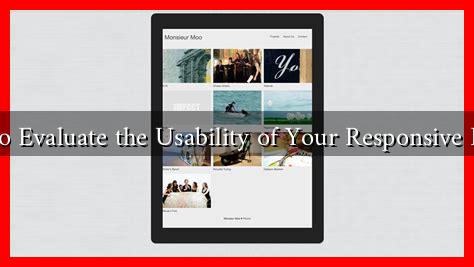-
Table of Contents
How to Evaluate the Usability of Your Responsive Design
In today’s digital landscape, responsive design is not just a trend; it’s a necessity. With the increasing variety of devices used to access the internet, ensuring that your website is usable across all platforms is crucial. However, creating a responsive design is only half the battle. The other half involves evaluating its usability. This article will guide you through effective methods to assess the usability of your responsive design, ensuring that your users have a seamless experience regardless of the device they use.
Understanding Usability in Responsive Design
Usability refers to how easy and satisfying a website is to use. In the context of responsive design, it encompasses several factors:
- Accessibility: Can users easily navigate your site on different devices?
- Functionality: Do all features work as intended across various screen sizes?
- Visual Hierarchy: Is the content organized in a way that makes sense on all devices?
- Loading Speed: Does your site load quickly on mobile and desktop?
Evaluating these aspects will help you identify areas for improvement and enhance the overall user experience.
Methods for Evaluating Usability
There are several effective methods to evaluate the usability of your responsive design:
User Testing
User testing involves observing real users as they interact with your website. This method provides invaluable insights into how users navigate your site and where they encounter difficulties. Here’s how to conduct user testing:
- Recruit a diverse group of participants who represent your target audience.
- Ask them to complete specific tasks on your site while thinking aloud.
- Observe their interactions and take notes on any challenges they face.
For example, a case study by the Nielsen Norman Group found that user testing can reveal usability issues that even the most experienced designers might overlook. By addressing these issues, companies can significantly improve user satisfaction and retention.
Analytics Review
Utilizing web analytics tools can provide quantitative data on how users interact with your site. Key metrics to analyze include:
- Bounce Rate: A high bounce rate may indicate that users are not finding what they expect.
- Session Duration: Short session durations can suggest that users are struggling to engage with your content.
- Conversion Rates: Low conversion rates may highlight usability issues in your design.
Tools like Google Analytics can help you track these metrics and identify patterns that may indicate usability problems.
Heuristic Evaluation
Heuristic evaluation involves reviewing your website against established usability principles. This method can be performed by usability experts or trained team members. Key heuristics to consider include:
- Consistency and Standards: Are similar elements presented in a consistent manner?
- Error Prevention: Does your design help users avoid mistakes?
- Flexibility and Efficiency: Can experienced users navigate quickly?
By systematically evaluating your design against these heuristics, you can identify areas for improvement that enhance usability.
Tools for Usability Evaluation
Several tools can assist in evaluating the usability of your responsive design:
- UserTesting: A platform for conducting user tests and gathering feedback.
- Hotjar: Provides heatmaps and session recordings to visualize user behavior.
- Optimizely: A/B testing tool that helps you test different design variations.
These tools can provide both qualitative and quantitative data, helping you make informed decisions about your design.
Conclusion
Evaluating the usability of your responsive design is essential for creating a positive user experience. By employing methods such as user testing, analytics review, and heuristic evaluation, you can identify usability issues and make necessary improvements. Utilizing tools like UserTesting, Hotjar, and Optimizely can further enhance your evaluation process. Remember, a well-designed responsive website not only attracts visitors but also keeps them engaged, ultimately leading to higher conversion rates and customer satisfaction. Prioritize usability in your design process, and you will reap the rewards of a loyal user base.

